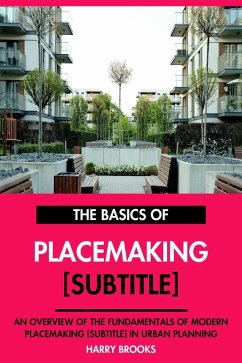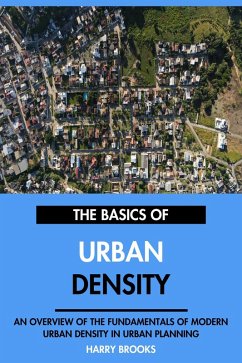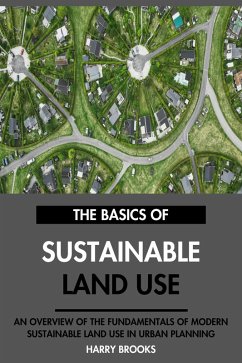
The Basics of Modern Vertical Urbanism: An Overview of the Fundamentals of Vertical Urbanism in Urban Planning. (eBook, ePUB)

PAYBACK Punkte
0 °P sammeln!
As urban populations continue to swell, the need for innovative solutions to housing, transportation, and public spaces becomes increasingly urgent. The concept of vertical urbanism emerges as a beacon of hope, offering a framework for reimagining how we live, work, and interact within our cities. This eBook delves into the intricacies of vertical urbanism, exploring its principles, applications, and the profound impact it can have on urban planning.In the following chapters, we will examine the fundamental aspects of vertical urbanism, from its historical context to its contemporary relevance...
As urban populations continue to swell, the need for innovative solutions to housing, transportation, and public spaces becomes increasingly urgent. The concept of vertical urbanism emerges as a beacon of hope, offering a framework for reimagining how we live, work, and interact within our cities. This eBook delves into the intricacies of vertical urbanism, exploring its principles, applications, and the profound impact it can have on urban planning.
In the following chapters, we will examine the fundamental aspects of vertical urbanism, from its historical context to its contemporary relevance. We will explore how vertical living can address pressing issues such as sustainability, social equity, and urban density. Each chapter is designed to provide a comprehensive understanding of vertical urbanism, highlighting its potential to transform urban landscapes and enhance the quality of life for residents.
The journey through this eBook is not just an exploration of architectural and planning concepts; it is an invitation to envision a future where cities are designed with the needs of their inhabitants at the forefront. Vertical urbanism challenges us to rethink our relationship with urban spaces, encouraging us to embrace density without sacrificing livability. As we navigate the complexities of modern urban life, the principles of vertical urbanism will serve as a guiding light, illuminating pathways toward more sustainable, inclusive, and vibrant cities.
In this context, the role of urban planners, architects, and community stakeholders becomes paramount. Collaboration and engagement are essential to ensure that vertical developments reflect the aspirations and needs of diverse populations. As we delve into the chapters ahead, we will uncover the stories of cities that have successfully implemented vertical urbanism strategies, as well as the lessons learned from those still grappling with the challenges of urban growth.
Ultimately, this eBook aims to inspire a new generation of urban thinkers and practitioners to embrace the possibilities of vertical urbanism. By fostering a deeper understanding of its principles and applications, we can collectively work toward creating urban environments that are not only functional but also enriching for all who inhabit them. The future of our cities depends on our ability to innovate, adapt, and envision a world where vertical urbanism is not just a concept but a reality that enhances the urban experience for generations to come.
In the following chapters, we will examine the fundamental aspects of vertical urbanism, from its historical context to its contemporary relevance. We will explore how vertical living can address pressing issues such as sustainability, social equity, and urban density. Each chapter is designed to provide a comprehensive understanding of vertical urbanism, highlighting its potential to transform urban landscapes and enhance the quality of life for residents.
The journey through this eBook is not just an exploration of architectural and planning concepts; it is an invitation to envision a future where cities are designed with the needs of their inhabitants at the forefront. Vertical urbanism challenges us to rethink our relationship with urban spaces, encouraging us to embrace density without sacrificing livability. As we navigate the complexities of modern urban life, the principles of vertical urbanism will serve as a guiding light, illuminating pathways toward more sustainable, inclusive, and vibrant cities.
In this context, the role of urban planners, architects, and community stakeholders becomes paramount. Collaboration and engagement are essential to ensure that vertical developments reflect the aspirations and needs of diverse populations. As we delve into the chapters ahead, we will uncover the stories of cities that have successfully implemented vertical urbanism strategies, as well as the lessons learned from those still grappling with the challenges of urban growth.
Ultimately, this eBook aims to inspire a new generation of urban thinkers and practitioners to embrace the possibilities of vertical urbanism. By fostering a deeper understanding of its principles and applications, we can collectively work toward creating urban environments that are not only functional but also enriching for all who inhabit them. The future of our cities depends on our ability to innovate, adapt, and envision a world where vertical urbanism is not just a concept but a reality that enhances the urban experience for generations to come.
Dieser Download kann aus rechtlichen Gründen nur mit Rechnungsadresse in A, B, CY, CZ, D, DK, EW, E, FIN, F, GR, H, IRL, I, LT, L, LR, M, NL, PL, P, R, S, SLO, SK ausgeliefert werden.













